Beschreibung
The Kalloni Saltpans consists of an extensive area of saltpans, located on the northern side of the Kólpos Kallonís Bay in the center of the island of Lesvos. It is (possibly) thé best place for birdwatchers on the island! The saltpans cover about 260 ha and consists of numerous rectangular-shaped pans. The water levels differs continually during each season. The area is a hotspot for so many species of birds, being mainly waders, gulls, terns and so many more species.
The western part of the area contains the two biggest saltpans and are also provide the best feeding habitat for birds. The area is of great importance for several species of breeding birds, like Stelzenläufer and Zwergseeschwalbe, but the main attraction are the large flocks of migratory birds that use the area is stop-over during their migration south- and northwards. Spring migration is definitely a peak in the area, but autumn migration can still be very overwhelming.
Waders can be very numerous in the two northwestern saltpans. Common species, that can be observed by hundreds of individuals, are Säbelschnäbler, Bruchwasserläufer, Rotschenkel, Seeregenpfeifer and Zwergstrandläufer. These saltpans are also home to huge flocks of Rosaflamingo and numbers can reach over 2000+ individuals at a time! Many species of duck can be seen here too, like Löffelente, Brandgans, Krickente and Knäkente. In spring, flocks of Weißbart-Seeschwalbe and Weißflügel-Seeschwalbe can be easily observed, flying low over the pans or resting on the smaller mudflats in the center. Gulls tend to hang around in large flocks too, like Schwarzkopfmöwe, Mittelmeermöwe and Dünnschnabelmöwe.
On the western side of these saltpans, a broad shallow channel is located and provides an ideal foraging habitat for many of the mentioned species above. Other species that can be seen here, foraging, are Schwarzstorch, Flußseeschwalbe, Seidenreiher and Temminckstrandläufer, among many others. When observing them by car, they tend to stay put and are easily photographed.
Adjacent to the tarmac road next to these saltpans, electricity lines are present which are great for many species of songbird and others, like Bienenfresser, Haubenlerche, Rotkopfwürger and Grauammer. The fields west of here are great for calling Wachtel and many species, like chats, shrikes, buntings, warblers and hunting harriers, like Rohrweihe.
Details
Zugang
The area is easy accessable by car, due to the tarmac road adjacent to the pools. Two observations huts are present which give a great overview of the area. The Kalloni Saltpans are not allowed to be entered, so stay away from the maintenance roads leading through the saltpans!!





